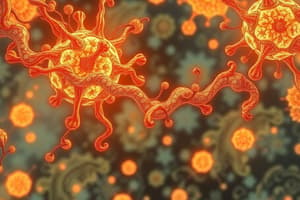Podcast
Questions and Answers
What are enzymes made of?
What are enzymes made of?
Proteins
What role do enzymes play in biological reactions?
What role do enzymes play in biological reactions?
They act as catalysts.
What conditions are required for enzymes to function effectively?
What conditions are required for enzymes to function effectively?
The correct temperature and pH.
Which enzyme is known to function in the acidic environment of the stomach?
Which enzyme is known to function in the acidic environment of the stomach?
What type of enzymes break down fats?
What type of enzymes break down fats?
What is the optimum temperature for the enzymes in the baby food to function?
What is the optimum temperature for the enzymes in the baby food to function?
Why is it necessary to throw away baby food heated above 37°C?
Why is it necessary to throw away baby food heated above 37°C?
State one importance of heating food to its correct temperature.
State one importance of heating food to its correct temperature.
Which pH value was determined as the optimum for amylase activity?
Which pH value was determined as the optimum for amylase activity?
Explain why the student concluded that the optimum pH for amylase was not shown in the results.
Explain why the student concluded that the optimum pH for amylase was not shown in the results.
Flashcards are hidden until you start studying
Study Notes
Enzymes
- Enzymes are proteins.
- Proteins are made up of amino acids.
- Enzymes act as biological catalysts.
- Enzymes need the correct temperature and pH to work rapidly.
- Protease is an enzyme that works in the acidic conditions of the stomach.
- Acidic conditions kill many bacteria present in food.
- Salivary amylase stops working in acidic conditions.
- Lipases break down fats.
Enzyme Investigations
- Amylase breaks down starch into reducing sugars.
- Iodine solution is used to test for the presence of starch.
- Iodine solution turns blue-black in the presence of starch.
- The time it takes for the iodine solution to stop turning blue-black indicates the rate of amylase activity.
- Measuring the rate of enzyme activity involves measuring the time for a reaction to occur.
Enzyme Action and Specificity
- Each enzyme has a specific shape that fits a specific substrate.
- The active site of an enzyme is where the substrate binds.
- The lock-and-key model explains how enzymes work.
- A substrate is a molecule that an enzyme acts upon.
Enzymes and Temperature
- All enzymes have an optimum temperature at which they work best.
- The rate of enzyme activity increases as the temperature rises until it reaches the optimum temperature.
- Above the optimum temperature, the rate of enzyme activity decreases.
- Enzymes become denatured at high temperatures, losing their shape and function.
- The optimum temperature for enzymes in baby food is 37°C.
Enzymes and pH
- The pH of a solution affects the shape of the enzyme and its active site.
- Each enzyme has an optimum pH at which it works best.
- The optimum pH for amylase is 6.
- The pH value tested that is closest to the optimum pH for amylase is the pH at which it is most active.
Additional Enzyme Information
- Pepsin breaks down proteins.
- Gastric proteases are found in the stomach.
- The optimum pH for gastric protease would be acidic because it is found in the stomach.
Other Factors Affecting Enzyme Activity
- Other factors besides temperature that can affect the rate of enzyme activity include:
- pH
- Substrate concentration
- Enzyme concentration
- The presence of inhibitors
Pancreatic Cancer
- Pancreatic cancer can lead to weight loss as it affects production of digestive enzymes.
- Enzyme specificity is critical in digestion as certain enzymes are required to break down specific types of food.
Monoclonal Antibodies
- Monoclonal antibodies can be used to treat pancreatic cancer.
- Monoclonal antibodies are specific to certain antigens.
Thermophilic Bacteria
- Thermophilic bacteria are a type of bacteria that can survive high temperatures.
- Thermophilic bacteria produce enzymes that are stable at high temperatures.
- Enzymes from thermophilic bacteria can be used in biological washing powder.
- Using enzymes from thermophilic bacteria can improve the cleaning performance of biological washing powder.
- Measuring absorbance using a colorimeter is an advantage over a visual color change method because it can be done more accurately.
Other Aspects of Enzyme Investigations
- The concentration of protein can be measured using a colorimeter.
- The absorbance value on a colorimeter gives an indication of how much light passed through the solution.
- The higher the absorbance, the darker the colour.
- The graph shows that the concentration of protein is almost the same in the solution both at 10 °C and 30 °C after 1 minute.
- The concentration of protein at 80 °C after 1 minute is different, which suggests the protease might be denatured at this temperature.
- The enzymes in biological washing powder are denatured at temperatures above 45 °C.
Studying That Suits You
Use AI to generate personalized quizzes and flashcards to suit your learning preferences.



